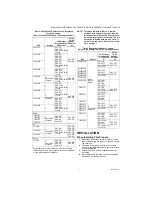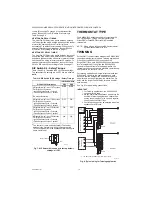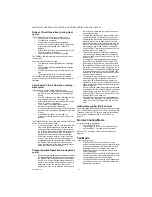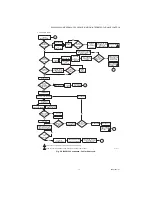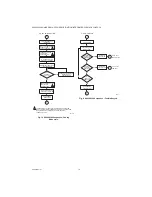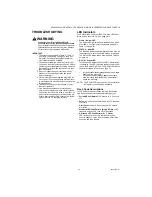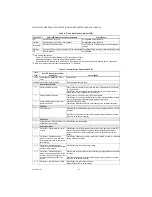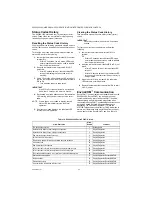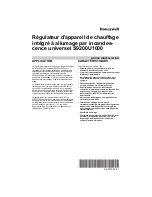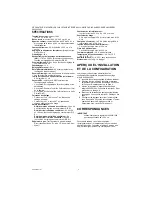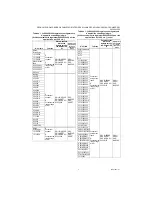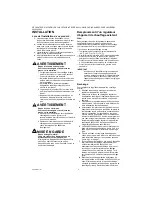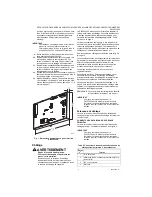
S9200U1000 UNIVERSAL HOT SURFACE IGNITION INTEGRATED FURNACE CONTROL
69-2075EF—01
16
Line Voltage and Earth Ground Sensing
The line voltage circuitry is monitored for reversed polarity in
Idle Mode in all non-fault related states except from HSI
warm-up.
— If reversed polarity is detected for longer than the
fault debouncing time, all requests for heat are
ignored.
— An error code flashes indicating line voltage polar-
ity is reversed. See Table 12 on page 20.
— An EnviraCOM™ alarm is active and sent on the
bus. See Table 14 on page 22.
— Fan and cool requests process as normal.
Line voltage sensing requires a 120 Vac (nominal) earth
ground referenced supply with an electrical connection
between the transformer secondary and earth ground.
Typical installations connect one side of the secondary to
the appliance chassis and the appliance chassis to earth
ground.
— If either the secondary to chassis connection, or
the chassis to earth ground connection are miss-
ing or providing poor electrical contact, the
S9200U1000 proceeds to “Self Check Lockout.”
— An error code flashes indicating there is no line
voltage ground present. See Table 12 on page 20.
— An EnviraCOM™ alarm is active and sent on the
bus. See Table 14 on page 22.
— Fan and cool requests process as normal.
These two faults (Line Voltage and Earth Ground
Sensing) are combined into one detectable fault.
Weak Flame Sensing
The S9200U1000 flashes an error code if, after a
successful Trial for Ignition and while operating in normal
fire mode, the S9200U1000 senses a weak flame signal
for longer than five seconds.
— When the flame is weak, the Flame (amber) LED
flashes indicating there is a poor flame signal. See
Table 12 on page 20.
— An EnviraCOM™ alarm is active and sent on the
bus. See Table 14 on page 22.
To clear the error code, a strong flame must be sensed for
longer than five seconds or the heat demand must be
removed.
Low 24 Vac Input Sensing
If low voltage on 24 Vac input is detected, the
S9200U1000 turns off all relays, ignore all requests, and
wait until the voltage recovers.
— The S9200U1000 flashes an error code indicating
low 24 Vac. See Table 12 on page 20.
— An EnviraCOM™ alarm is active and sent on the
bus. See Table 14 on page 22. The alarm may not
be received due to low line voltage, but will be
stored in the alarm history.
When the voltage recovers, the S9200U1000 returns to
normal operation five seconds after the fault clears.
Bad Fuse
Once a bad fuse is detected, the S9200U1000 behaves in
following manner:
— Thermostat requests that are in progress become
inactive and are finished as if they were removed.
— All new thermostat requests are ignored.
— The S9200U1000 flashes an error code indicating
a bad fuse. See Table 12 on page 20.
— An EnviraCOM™ alarm is active and sent on the
bus. See Table 14 on page 22. The alarm may not
be received due to low line voltage, but will be
stored in the alarm history.
Once a good fuse is detected, the S9200U1000 returns
back to normal operation through a micro reset.
Soft Lockout
Soft Lockout is intended to prevent initiation of a new
heating cycle for a certain time after the fault related to the
heating sequence occurs. Behavior in Soft Lockout is
defined as follows:
— Thermostat heat requests are ignored.
— Thermostat cool requests are served as normal.
— Fan requests are served as normal.
— The S9200U1000 flashes a fault code identifying
the fault that caused transition to the Soft Lockout.
See Table 12 on page 20.
— An EnviraCOM™ alarm indicating the fault is
active and sent on the bus. See Table 14 on
page 22.
The S9200U1000 is reset from Soft Lockout by any one of
the following three ways:
— Cycling power: Removing power for longer than
10 seconds.
— Thermostat Reset: Removing the call for heat for
longer than five seconds but less than 20 sec-
onds.
— Auto Restart: The S9200U1000 automatically
exits Soft Lockout after the Auto Restart Delay
expires if the cause of the Soft Lockout has
cleared.
Hard Lockout
Hard Lockout is intended to prevent initiation of a new
heating cycle after a serious fault related to heating (e.g.
rollout switch opening). Behavior in Hard Lockout is
defined as follows:
— Thermostat heat requests are ignored.
— Thermostat cool requests are served as normal.
— Fan requests are served as normal.
— The S9200U1000 flashes a fault code identifying
the fault that caused transition to the Hard Lock-
out. See Table 12 on page 20.
— An EnviraCOM™ alarm indicating that manual
reset is needed is active and sent on the bus. See
Table 14 on page 22.
The S9200U1000 remains in this state until manual power
reset.
Self Check Lockout
Self Check Lockout is intended to prevent initiation of a
new heating cycle after the self check mechanism has
detected a hardware fault. The S9200U1000 functionality
during a Self Check Lockout is defined as follows:
— Thermostat heat requests are ignored.
— Thermostat cool requests are served as normal.
— Fan requests are served as normal.
— The S9200U1000 flashes a fault code identifying
the fault that caused transition to the Self Check
Lockout. See Table 12 on page 20.
— An EnviraCOM™ alarm indicating the fault is
active and sent on the bus. See Table 14 on
page 22.
— The S9200U1000 remains in this state until the
fault disappears.
For the S9200U1000 to return back to normal operation,
no fault must be present for the Self Check Lockout
Return Delay, which is five minutes.
Operating Sequences
Fig. 9–11 beginning on page 17 describe the operations of
the S9200U1000 control.
Содержание S9200U1000
Страница 53: ...RÉGULATEUR D APPAREIL DE CHAUFFAGE INTÉGRÉ À ALLUMAGE PAR INCANDESCENCE UNIVERSEL S9200U1000 29 69 2075EF 01 ...
Страница 54: ...RÉGULATEUR D APPAREIL DE CHAUFFAGE INTÉGRÉ À ALLUMAGE PAR INCANDESCENCE UNIVERSEL S9200U1000 69 2075EF 01 30 ...
Страница 55: ...RÉGULATEUR D APPAREIL DE CHAUFFAGE INTÉGRÉ À ALLUMAGE PAR INCANDESCENCE UNIVERSEL S9200U1000 31 69 2075EF 01 ...




